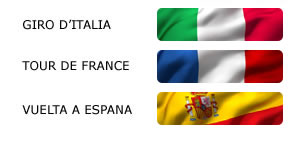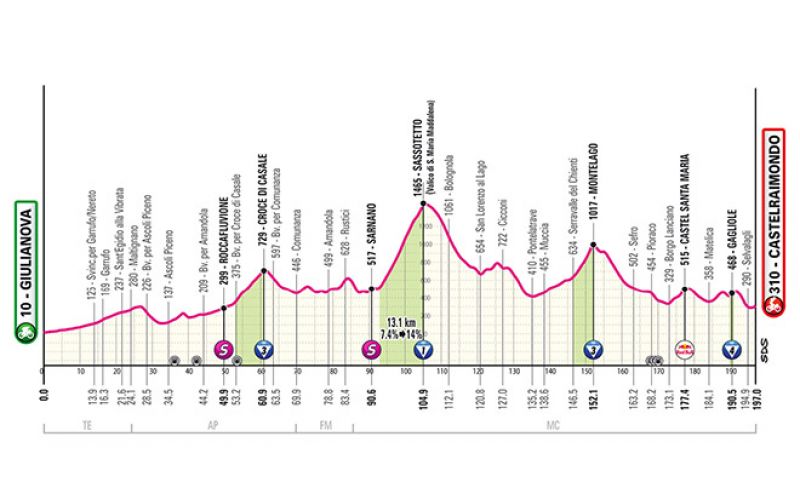

The second consecutive Apennine stage, eighth of the Giro, will take the group from Giulianova to Castelraimondo for 197 km with 3,800 meters of elevation gain. And as always when racing through Abruzzo and Marche, there's very little flat terrain.
to follow the live coverage of the entire stage starting at 12:15 CLICK HERE
After a brief approach - the first intermediate sprint is set after 43 kilometers in Roccafluvione - cyclists will enter the Teramo and Piceno Apennines heading towards Sarnano (the second intermediate sprint at km 90), from where they will tackle the climb of Sassotetto, Santa Maria Maddalena Pass: climbing to an altitude of 1,455 m on an ascent of 13.1 km at 7.4%.
The challenging descent leads to the final part where climbs and descents follow one another without pause. After Camerino, they will skirt Castelraimondo by covering a (open) loop of about 25 km. The finale is characterized by two short but steep climbs. The first leads to Castel Santa Maria (brief ramps at 12-13% over about 2 km). Subsequently, they will reach Matelica on a narrow road before heading to Gagliole where, 6.5 km from the finish, a short wall of 800 m at 12% with slightly higher peaks leads to the final challenging descent until 2 km from the finish line. Notable is the right turn about 400 m from the finish, entering the town with an uphill exit between 5% and 2% all the way to the finish, always on a slight incline.
THE TERRITORY. The monumental seafront of Giulianova, considered one of the most beautiful in Italy, is the best place to start the eighth stage of the Giro. It will be a challenging day with the continuous alternation of climbs, though never extreme, and descents. But it will also be a day that will fill eyes and hearts with surprises.
The historic center of Giulianova, situated on a hill overlooking the sea, is a true jewel of architecture and history, boasting monuments of great artistic interest such as the Church of San Flaviano, and it's pleasant to explore the Piazza della Libertà surrounded by historic buildings of value including the Ducal Palace and the Church of Sant'Antonio. A stop at the Belvedere, the quintessential panoramic point of the coast, and off we go.
The first kilometers develop in the Teramo hinterland, cradle of textile and leather excellence that has made the area one of the most renowned productive districts in the country.
Ascoli Piceno would deserve an entire weekend for the charm of its urban layout centered around Piazza del Popolo surrounded by historic buildings such as Palazzo dei Capitani del Popolo (with the Hall of Coats of Arms inside), the walls of the Church of San Francesco, Renaissance palaces, porticos and loggia. Piazza Arringo is also splendid, dominated by the Cathedral of Sant'Emidio, while stepping back two millennia walking on the Roman Augustan Bridge, dating back to the 1st century BC. The Ceramics Museum, set up in the church of San Tommaso, tells centuries of artistic majolica processing, the pride of Ascoli craftsmanship.
Amandola, gateway to the Sibillini Mountains preserves porticos and beautiful terracotta architectures, among which stand out the churches of Sant'Agostino (or sanctuary of Blessed Antonio) and San Francesco.
Then comes Sarnano that honors its inclusion in the club of the Most Beautiful Villages of Italy, with its original "castrum" form, a fortified village that winds in concentric circles from Piazza Alta and descends through alleys and houses to the base of the hill. A spectacle that the riders won't be able to appreciate, but for fans this is a mandatory stop.
Matelica, City of Wine and City of Honey, seduces with its flavors, particularly with Verdicchio di Matelica DOCG, also known as Mountain Verdicchio to distinguish it from the nearby Jesino version.
The symbol of Castelraimondo is the Cassero Tower, which at over 30 meters high dominates the panorama. Its majesty and the suggestive view over the city and surrounding hills make it an unmissable destination for those visiting this medieval village. Castelraimondo also hosts a unique institution in the national landscape: the National Museum of Folk Costume. Inside, a rich collection of traditional clothes from every Italian region tells the story of communities through precious fabrics, embroideries, and accessories. The history of Italy and its popular customs and traditions lives here.

Se sei giá nostro utente esegui il login altrimenti registrati.